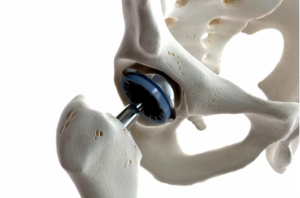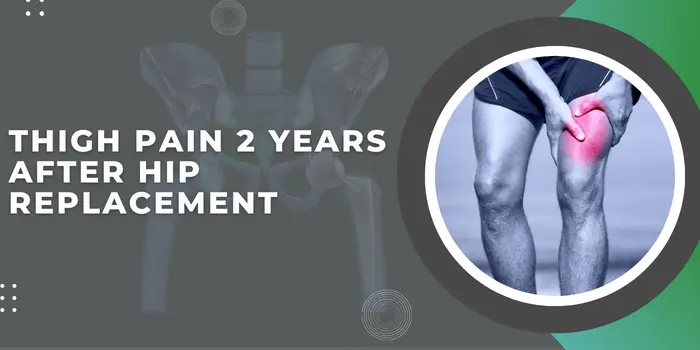Experiencing thigh pain 2 years after hip replacement surgery can be perplexing and discomforting. Get insights from Dr. Sandeep Singh, a renowned Orthopedic doctor in Bhubaneswar, delves into the potential causes, diagnosis, and treatment options for this condition. Understanding thigh pain in the context of hip replacement is crucial for effective management and prevention.
Are you experiencing discomfort? Don’t wait for your thigh pain to dictate your life. Schedule a consultation now!
Now Let’s understand more in-depth about how and why pain occurs even after a hip replacement.
Explanation of Why Thigh Pain Can Occur After Hip Replacement Surgery
Thigh pain after hip replacement surgery can stem from various factors, including the body’s response to the prosthetic implant, changes in biomechanics, and the healing process. It’s essential to consider that the thigh bone (femur) is integral to the success of hip replacement surgery, and discomfort in this area may signal underlying issues.
Now that you know about the insights of why thigh pain occurs, navigate what’s the real issue here by reading more!
Causes of Thigh Pain Two Years Post Surgery
Several factors can contribute to thigh pain 2 years after hip replacement, including:

- Loosening of the prosthetic implant: Sometimes, the artificial hip part or prosthetic doesn’t stay snug in the bone. It can move a little and cause pain in your thigh.
- Infection Post Hip replacement: After surgery, there’s a chance of getting an infection. This can hurt not just around the hip but also in the thigh area. You might see swelling, redness, or feel warmth.
- Inflamed Soft Tissues: The surgery can make the muscles and tissues around your hip inflamed. This can lead to a sore thigh because these tissues help your hip move and stay stable.
- Signs of a Serious Infection: If your thigh pain comes with other signs like fever, more redness, or the area feeling hot, it might mean the infection is worse and needs quick attention.
Get expert insights on thigh pain 2 years post hip replacement and take the first step towards pain-free living. Book an appointment today!
But remember, ignoring thigh pain won’t make it disappear. Let’s tackle it head-on! Know more further.
Diagnosing Thigh Pain After Hip Replacement
Diagnosis involves a thorough assessment by an Orthopedic doctor in Bhubaneswar. Techniques may include imaging tests like X-rays and MRIs to examine the implant’s positioning and check for any hip surgery complications.
Treatment Options for Thigh Pain After Hip Replacement
Managing thigh pain after a hip replacement depends on what’s causing the pain. Here are the main ways to treat it:
- Medication for Pain and Inflammation: Doctors often prescribe medicines to ease the pain and reduce swelling. These can include painkillers or anti-inflammatory drugs.
- Physical Therapy: A physical therapist can teach you exercises to strengthen the muscles around your new hip. Stronger muscles support the hip better and can reduce pain.
- Revision Surgery: If the pain is due to a problem with the hip implant, like it is loose, you might need another surgery to fix or replace it.
- Personalized Care Plans: Under Dr. Sandeep Singh’s care in Bhubaneswar, you’ll get a treatment plan that’s tailored just for you. This means the doctor will consider your specific situation and needs when deciding how to treat your thigh pain.
Preventions and Lifestyle Adjustments
Taking care of your new hip involves some key precautions to prevent pain and keep you moving smoothly. Here’s what you can do:
- Keep a Healthy Weight: Extra weight puts more pressure on your hip. Staying at a healthy weight helps keep that pressure off and reduces pain.
- Choose Low-Impact Exercises: Activities like swimming, biking, or walking are great for your hip. They keep you fit without putting too much strain on your new joint.
- Eat a Balanced Diet: Foods rich in calcium and vitamin D are good for bone health. Eating a variety of healthy foods helps your body heal and stay strong.
- Regular Check-Ups: See your orthopedic doctor They can check how your hip is doing and catch any issues early.
Experiencing thigh pain 2 years after your hip replacement? Get in touch with our experts for answers and relief. Your path to recovery starts with this conversation!
Guidance on recognizing signs and regular follow-ups with the orthopedic surgeon
For a smooth recovery after your hip replacement, watch out for any new or worsening symptoms like pain or swelling. Be aware of infection signs such as fever or redness. Regular check-ups with your orthopedic surgeon are crucial for monitoring your recovery and addressing any concerns early. Also strictly follow their advice on activities, exercises, and medications. Always communicate any unusual changes to your doctor promptly and follow their recommendations closely to ensure a smooth recovery.
Conclusion
While thigh pain 2 years after hip replacement can be alarming, understanding its causes and seeking timely intervention can significantly improve outcomes. Dr. Sandeep Singh, a leading Orthopedic doctor in Bhubaneswar, emphasizes the importance of early diagnosis and personalized treatment plans in managing this condition effectively.
Hip replacement recovery shouldn’t include chronic pain! If it does do Contact orthopedic surgeons now.
Frequently Asked Questions:
What causes thigh pain 2 years after hip replacement?
Thigh pain can result from the prosthetic implant loosening, infection, or soft tissue inflammation.
How do you get rid of thigh pain after hip replacement?
Treatment may include medications, physical therapy, or revision surgery, depending on the cause.
Can a hip replacement go bad after 2 years?
Yes, issues like implant loosening or infection can occur, necessitating a thorough evaluation by a healthcare professional.
Is thigh pain after hip replacement surgery common?
While not common, some patients do experience thigh pain, which an orthopedic surgeon should assess to rule out complications.


